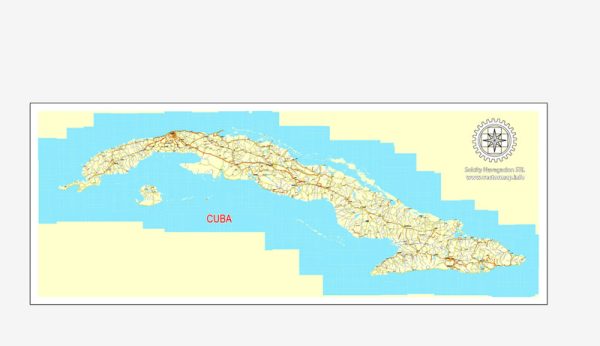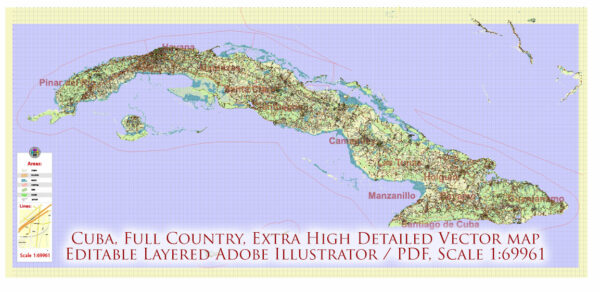The political and economic history of Cuba is complex and has been marked by a series of significant events and shifts over the centuries.
Vectormap.Net provide you with the most accurate and up-to-date vector maps in Adobe Illustrator, PDF and other formats, designed for editing and printing. Please read the vector map descriptions carefully.
Here is a detailed overview:
Pre-Revolutionary Period:
Indigenous Peoples and Spanish Colonization (Pre-1492 – 1898):
- Before the arrival of Christopher Columbus in 1492, the island was inhabited by indigenous peoples known as the Taíno.
- Cuba became a Spanish colony after Columbus’s arrival, and it remained under Spanish rule for nearly four centuries.
- The Spanish established large sugar plantations using forced indigenous labor and later African slaves.
Sugar Economy and Slavery (16th – 19th centuries):
- The development of the sugar industry shaped Cuba’s economy, leading to an increased reliance on African slave labor.
- The island’s wealth grew through the export of sugar, tobacco, and other agricultural products.
Struggle for Independence (19th century):
- Cuban desire for independence from Spanish rule grew in the 19th century.
- Several uprisings, such as the Ten Years’ War (1868-1878) and the Little War (1879-1880), were unsuccessful in gaining independence.
- The Cuban War of Independence (1895-1898), led by figures like José Martí and Antonio Maceo, gained international attention.
Spanish-American War and U.S. Occupation (1898 – 1902):
- The sinking of the USS Maine in Havana Harbor in 1898 played a role in the outbreak of the Spanish-American War.
- The U.S. defeated Spain, and the Treaty of Paris in 1898 ceded Cuba to the United States.
- The U.S. governed Cuba until 1902, when it gained formal independence, but the Platt Amendment allowed the U.S. to intervene in Cuban affairs.
Republic and Political Turmoil (1902 – 1959):
Economic Dependence and Political Instability:
- The Cuban economy remained reliant on sugar exports, making it vulnerable to fluctuations in the global market.
- Political instability characterized much of this period, with frequent changes in leadership and a series of coups.
Fulgencio Batista’s Regime (1940 – 1944 and 1952 – 1959):
- Batista initially came to power in 1940 through elections but later staged a coup in 1952.
- His regime was marked by corruption, repression, and close ties to the United States.
Cuban Revolution (1953 – 1959):
Rise of Fidel Castro and the 26th of July Movement:
- Fidel Castro, along with Che Guevara and others, led the 26th of July Movement against Batista’s regime.
- The revolution included guerrilla warfare and gained support from various sectors of society.
Establishment of Socialist State (1959 onward):
- Castro assumed power in 1959, initiating land reforms, nationalization of industries, and alignment with the Soviet Union.
- The U.S. imposed an economic embargo on Cuba in response to its alignment with communism.
- The Bay of Pigs invasion in 1961 and the Cuban Missile Crisis in 1962 heightened tensions between Cuba and the U.S.
Post-Revolutionary Period:
Economic Challenges and Soviet Support (1960s – 1980s):
- Cuba’s economy became heavily dependent on Soviet aid, leading to economic difficulties after the collapse of the Soviet Union in 1991.
- The “Special Period” in the 1990s witnessed economic hardship, shortages, and increased isolation.
Contemporary Developments (1990s – Present):
- Despite economic challenges, Cuba maintained its socialist system, including free education and healthcare.
- In recent years, there have been some economic reforms, allowing limited private enterprise.
- The death of Fidel Castro in 2016 marked a symbolic shift in leadership, with his brother Raúl Castro stepping down in 2018.
Conclusion:
Cuba’s political and economic history is shaped by its colonial past, struggle for independence, revolution, and subsequent efforts to navigate a path between socialist principles and economic realities. The island’s history reflects complex interactions with global powers, particularly the United States and the Soviet Union, and continues to be a subject of international interest and debate.



 Author: Kirill Shrayber, Ph.D.
Author: Kirill Shrayber, Ph.D.